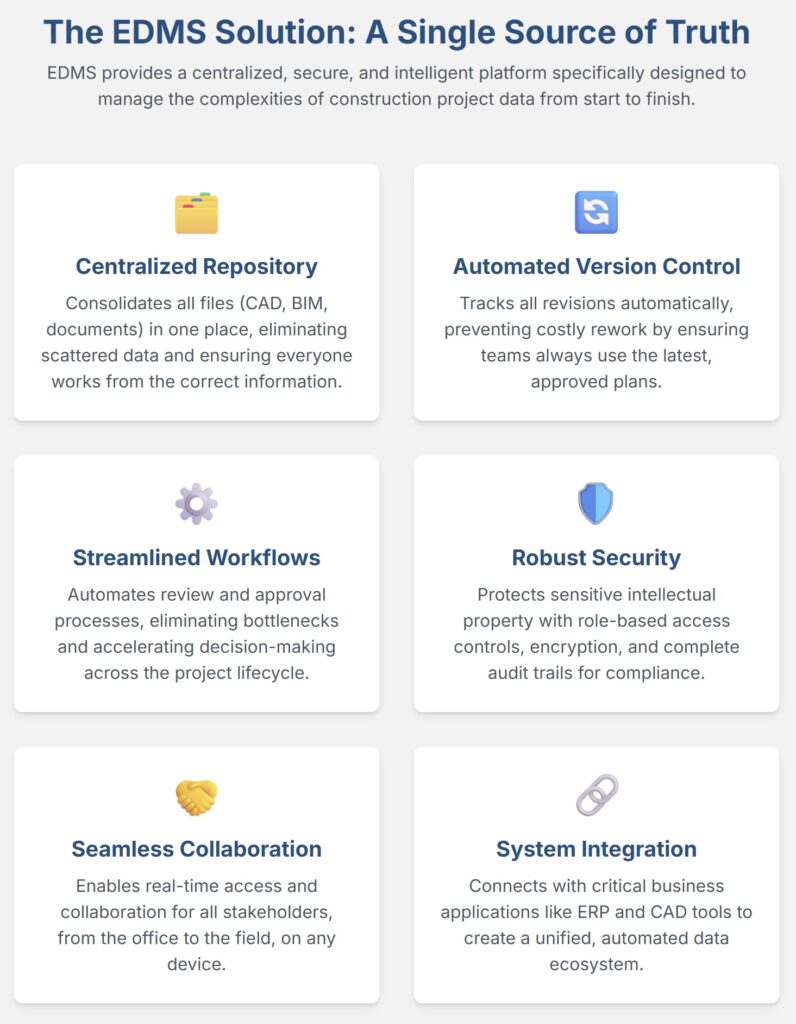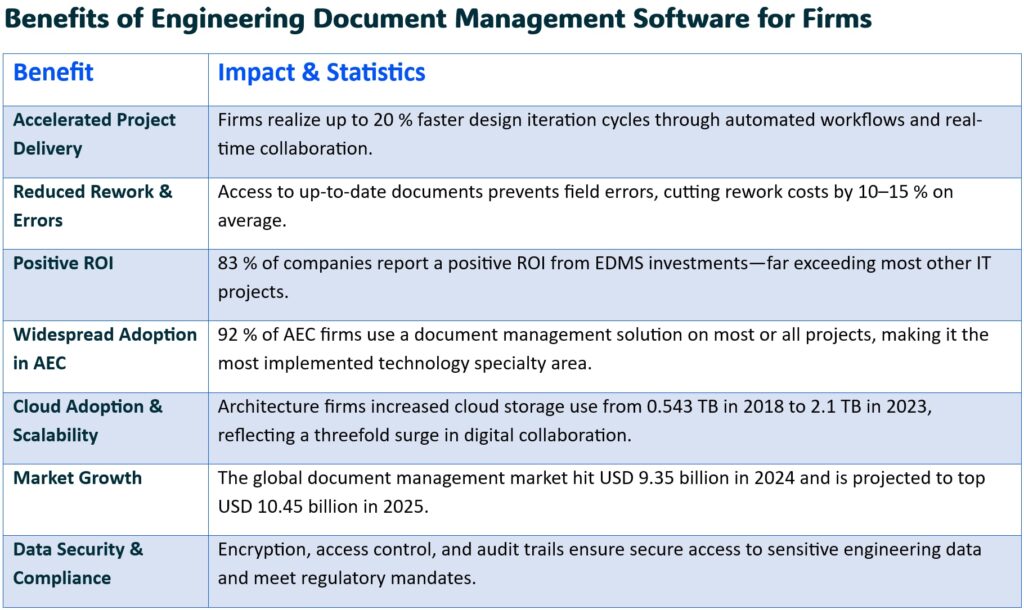Introduction
Engineering projects produce an ever-growing mountain of technical drawings, BIM models, submittals, regulatory reports and scanned paper documents. Without engineering data management facilitates software to unify storage, enforce version control and automate workflows, teams waste hours searching drives or inboxes and risk costly errors from outdated files. A robust engineering data management system enhances data security and brings all critical documents into one source of truth, integrates with CAD/BIM tools, provides mobile access and builds immutable audit trails—turns document chaos into operational efficiency and compliance.
What Is Engineering Data Management Software?
An engineering data management system (EDMS) or engineering document management software is a purpose-built platform that stores, organizes and governs all engineering documents for engineering organizations —DWG, RVT, IFC, PDF contracts, specifications, legal files and more—within a Common Data Environment (CDE). Unlike generic document management software, the right document management system offers:
- Engineering-specific metadata (project codes, revision numbers, discipline tags, compliance checkpoints) for precise search, sorting and filtering.
- CAD/BIM integrations (AutoCAD, Revit, Civil 3D, MicroStation) so users open and save files directly from design apps without manual exports.
- Audit trails capturing every upload, download, approval and redline, with time-stamps and user IDs to satisfy compliance needs.
- Automated version control: check-in/check-out, branch/merge support and graphical compare tools prevent conflicting edits and stale revisions.
Core components of document management systems (EDMS):
- Secure storage layer – cloud or on-premise object/file servers with encryption and disaster recovery (mckinsey.com)
- Metadata database that indexes document attributes and custom schemas
- Workflow engine for configurable review, approval and transmittal processes
- APIs and connectors for CAD/BIM tools, ERP, PLM and CMMS to embed document lifecycle into engineering workflows
- Mobile interface with offline sync for field engineers to view, annotate and upload as-built drawings
A modular, microservices-based architecture allows EDMS to scale from small civil-works boutiques to global EPC contractors managing thousands of projects. Open APIs enable integration of AI-driven metadata tagging, IoT data and advanced analytics to deliver necessary data —turns raw engineering data processing into actionable insights.

Challenges Faced Without a Data Management System
Without a data management system, engineering teams are faced with a web of inefficiencies that slow down projects and increase risk. Manual file storage across local drives and paper documents creates data silos, making version control impossible. Engineers spend an estimated 30% of their time searching for the right engineering documentation, drawing or specification, according to AIIM research. Disconnected processes force teams to email large CAD files, causing transmission errors and confusion over document versions. In global construction, poor data quality has cost $1.8 trillion in 2020, with rework accounting for 14% of that figure. Regulatory compliance suffers when critical legal files or organization’s engineering drawings are lost or outdated.
Adding to these challenges, lack of audit trails means traceability of decisions is weak. When disputes arise, firms can’t easily identify change authors, timestamps or approval histories, highlighting the need for effective data management policies exposing them to litigation and non-compliance fines. Disaster recovery procedures often rely on ad hoc backups—USB drives or paper copies—that risk total data loss during natural or human-made disasters. FEMA reports 40–60% of small businesses never recover after a disaster due to document loss.
To enhance collaboration across engineering teams and disciplines, is constrained, as mobile devices and field staff lack access to up-to-date information. Field technicians working with outdated models can introduce errors that propagate through the engineering workflow, resulting in rework and safety hazards. Manual document processes also impede scalability: as projects grow, the volume of engineering documents multiplies, overwhelming traditional document management systems, inflating administrative costs and delaying decision-making.
Without the best document management systems or an electronic document management system, firms can’t enforce standard naming conventions, metadata tagging and structured file storage. This lack of organization prevents search and engineering data management software from delivering valuable insights into performance metrics. Without central control, data security measures for sensitive engineering data is vulnerable to unauthorized access and breaches, threatening data security and client confidentiality. Ultimately, firms without a formal document management system edms lose operational efficiency, project risk and competitive advantage. Teams lose visibility into document change history.
How Engineering Document Management Systems Improve Project Efficiency
Engineering document management systems speed up collaboration and compress project schedules by removing manual bottlenecks. Automated version control ensures the latest document versions are always available, reducing rework due to outdated plans. In a study by FMI, better document management resulted in 6% labor productivity improvement for 79% of contractors, which can also reflect positively in their financial reports . Workflow automation routes engineering documents through defined review and approval paths, triggers notifications when tasks are pending so critical documents move quickly through the engineering workflow. Metadata-driven search reduces document storage retrieval time by up to 30% so teams can focus on value-added tasks instead of file searching.
Integration with CAD, BIM and ERP platforms embeds document management into design environments. For example, CAD users can open the latest assembly drawings directly from the EDMS without leaving their modeling tool, preventing file-export errors and ensuring secure access. Mobile device support lets field engineers retrieve and annotate BIM models on tablets in real-time, acting as a document organizer improving on-site decision making and reducing RFIs. An electronic dms focused specifically with audit trails provides a clear record of who modified which engineering documents and when, simplifying compliance audits and dispute resolution.
By centralizing evidence of approvals, EDMS solutions reduce the risk of compliance violations and streamline regulatory reporting. Cloud computing and redundant backups form the backbone of disaster recovery, ensuring data integrity if on-premise systems fail. Dashboards offer engineering managers valuable insights into bottlenecks, average review times and document version counts so they can continuously refine the process. According to a case study, firms using centralized EDMS reported up to 20% faster project completion and 50% faster vendor document turnaround .
In turn, teams experience better collaboration across disciplines as stakeholders share a unified common data environment. Engineering Data Management System eliminates email-based file sharing errors, enforces access control and secures sensitive engineering data. The system streamlines document management across the entire product lifecycle—from concept to handover—managing electronic files, enabling real-time editing and seamless collaboration.
Top Benefits of Engineering Document Management Software in Structural Engineering Projects

Engineering document management software delivers measurable results across multiple business processes and dimensions, giving architecture, engineering and construction firms a competitive edge. Below are the top benefits of an engineering data management software solution:
Faster Review Cycles and Less Rework
Automated workflows, version control and transmittal logs reduce review steps, up to 40% faster average approval times. Engineers no longer spend hours reconciling multiple document versions and eliminating costly rework.
Data Integrity and Compliance
By enforcing standardised naming conventions, metadata fields and structured document storage, an engineering document management system maintains data accuracy throughout the project lifecycle. Audit trails and access control features provide transparent records of who accessed or modified documents, simplifying regulatory reporting, enhancing data validation and reducing legal risks for sensitive engineering data and regulatory compliance.
Better Collaboration and Visibility
A centralised common data environment simplifies file sharing among engineering teams, project managers and external partners. Mobile device support and offline sync lets field crews access up-to-date drawings and engineering documents on tablets or smartphones, reducing RFIs and enabling immediate feedback during site inspections.
Cost Savings through Operational Efficiency
Removing paper documents, duplicate storage and manual distribution reduces administrative overhead and physical file storage costs. Cloud computing, automated backups and disaster recovery plans are crucial to manage engineering documents, protect against data loss, minimise downtime and lower IT maintenance costs.
Actionable Insights with Analytics and Reporting
Built-in dashboards provide valuable insights into document turnaround times, pending approvals and revision counts. Managers use these metrics to refine processes and drive continuous improvement.
Scalability and Integration Flexibility
Modern engineering document control software supports a wide range of file formats—from 2D CAD to 3D BIM models—and integrates seamlessly with ERP, PLM and project management platforms.

Firms that implement the best document management systems report up to 20% faster project completion rates and recover implementation costs within 12 months. In addition to secure data storage and streamlined engineering workflows, companies get a resilient, future-proof platform that drives operational efficiency and collaboration, so they can succeed in complex engineering environments. In the engineering world, this means consistent document storage and reliable file sharing.
How to Choose the Right Engineering Data Management Software for Complex Engineering Projects
Choosing the right engineering data management software is a strategic decision that impacts how engineering projects perform. Follow these steps to find a solution that meets your organisation’s needs and improves document management.
Conduct a Needs Assessment
Map current workflows, document types and pain points. Estimate document volume and revision frequency. Identify regulatory, audit and disaster recovery requirements to ensure compliance and data security.
Define Feature Requirements
Create a checklist of core capabilities: automatic version control, metadata-driven search, audit trails, access control, workflow automation, mobile support and disaster recovery. Prioritize features that streamline engineering workflow, such as CAD/BIM integration and electronic document management system functions.
Connect to CAD, BIM, ERP, PLM, project management tools
Native connectors and APIs reduce manual exports and maintain data integrity across engineering contexts.
Security & Compliance
Role-based access control, encryption at rest and in transit, audit logs. ISO 9001 or data protection modules for sensitive engineering data and legal files.
Scalability & Deployment
Cloud, on-premise or hybrid. Storage limits, performance under load, capacity for growth in complex engineering projects.
Vendor Support & Roadmap
Stability, product roadmap, support responsiveness, uptime guarantees. References from similar engineering companies.
Total Cost of Ownership (TCO)
Subscription vs perpetual licensing, implementation, training, maintenance costs. Efficiency gains—reduced rework and faster approvals—to estimate ROI.
Pilots & Feedback
Deploy a trial for a small team or project. Monitor performance, search, collaboration, user satisfaction to validate the product.
Also consider user experience and training resources for seamless adoption. Roadmap for future trends, AI-driven insights and digital twins.
| Criterion | Key Considerations |
|---|---|
| File format support | DWG, DGN, RVT, IFC, PDF/A—native handling without conversion |
| Workflow engine flexibility | Conditional approvals, parallel reviews, automated transmittals |
| Integration and APIs | Native plugins, REST APIs, webhooks for CAD/BIM, ERP, PLM, CMMS |
| Security and compliance | Encryption, MFA, audit trails, ISO 27001, GDPR alignment |
| UX and training | Desktop/mobile usability, vendor training, in-app help |
| Scalability and performance | Handling growing document volumes and concurrent users |
| Analytics and reporting | Dashboards on document lifecycle, turnaround times, collaboration metrics |
| Licensing and costs | SaaS vs. perpetual, storage fees, support and upgrade charges |
| Future trends and AI | AI-driven tagging, predictive bottleneck analysis, blockchain traceability |
By following these steps, engineering managers can choose the right document control software that manages documents, collaboration and delivers project efficiency gains.In summary, an engineering data management system changes how teams work with complex engineering documents. By storing documents centrally, controlling versions and offering metadata search and audit trails an engineering data management system solution improves collaboration, data integrity and project efficiency. Integrations with CAD, BIM and ERP systems allow engineering managers to access the data they need quickly, while secure access and disaster recovery protects sensitive engineering data. Companies that invest in the right document control software get error reduction, compliance and insights across the product lifecycle. By adopting this technology they will be ready for complex engineering projects.
Conclusion
Engineering document management software is no longer a nice to have for AEC companies working on complex, multi-disciplinary projects. By centralising documents, automating revisions, enforcing compliance and enabling seamless collaboration an EDMS is the backbone of modern engineering workflows for asset intensive industries . As the market grows—expected to reach USD 10 billion soon—companies that invest in the right engineering data management system will get a head start: faster delivery, fewer errors and a secure, auditable record of every decision and change.
Implementing the right engineering document management system requires a needs assessment, CAD/BIM integration, robust security and user adoption. When done right EDMS turns document control from a bottleneck into an enabler—allowing engineering teams to innovate faster and deliver with confidence.
Book your Demo with BuildTwin Success Advisor


